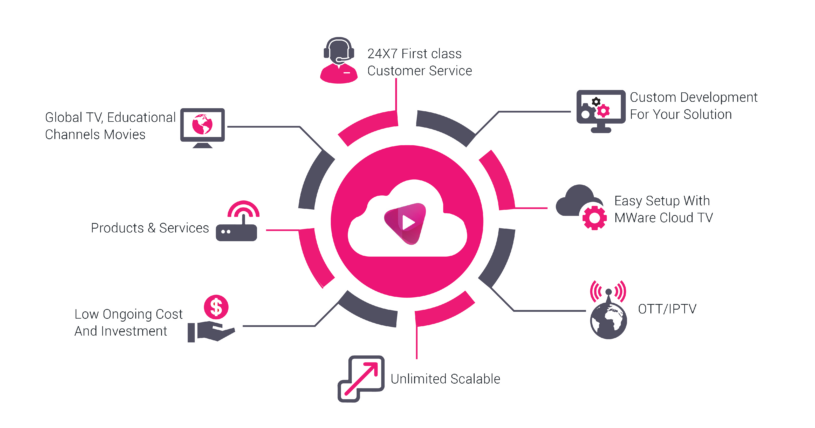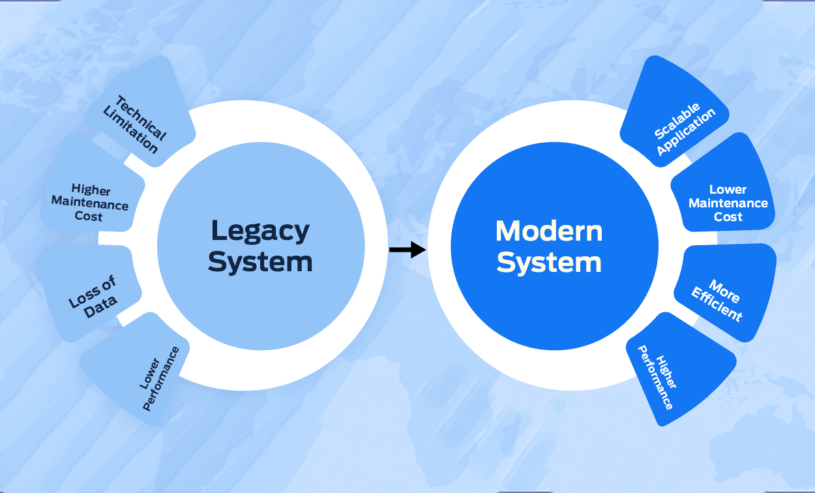Are you looking for reliable OTT middleware to run your video streaming service? This blog post serves as a comprehensive guide to the main features of OTT middleware that helps you launch your streaming platform seamlessly.
With this in mind, let’s explore the essential components a high-performance middleware must possess.
Types of OTT Middleware

OTT Middleware is one of the most important elements of a successful video streaming service. It is used to facilitate ingestions, transcodings, monetization, content gaming, and delivery to customers. Generally, there are two types of software for OTT management – proprietary and open-source.
Proprietary: Proprietary OTT middleware is often custom-built for each client based on their requirements. It usually takes longer to set up than open-source software but provides high scalability along with the assurance that the architecture is secure for commercial use. This type of middleware typically includes a backend service and associated APIs with standard integration options such as DRM, social media networks, and payment gateways.
Open-Source OTT Middlewares: Open-source software is inexpensive to set up and can rapidly be tailored as needed during implementation or when making regular upgrades in order to ensure that the product remains competitive in the industry. They are modular systems designed using open source technology stacks such as cloud computing models like AWS or Google Cloud Platform along with popular technologies like NodeJS, Red Hat Linux, MySQL Databases, etc., providing unprecedented flexibility to customize features quickly when required without having to rely on developers writing codes from scratch every time an upgrade has to be made.
Features of OTT Middleware

OTT (Over-the-top) Middleware is software designed to manage content for a video streaming service. It typically provides features such as authentication and authorization, content management, streaming and playback, analytics, security, payments processing, and more. All these features work together to create a smooth and reliable user experience for streaming services.
Here are some of the core functionalities offered by an OTT middleware:
Authentication and authorization
OTT middleware allows users to authenticate themselves with an ID or login credentials before they can access the streaming service. It also protects against unauthorized access by implementing various control mechanisms such as role-based access control, token-based authentication, etc.
Content management:
The software helps streamline video content management tasks such as uploading and airing new content, scheduling broadcasts or publishing live streams, etc. It can also integrate with other systems such as email services or advertising networks for effective marketing campaigns.
Streaming & Playback
OTT helps optimize both live & on-demand videos for different speeds of internet connections including mobile networks. This ensures that users have a high-quality streaming experience regardless of their device or network speed. It also has features like adaptive bitrate streaming which automatically switches between different bitrates depending on device & network conditions for better quality streams.
Analytics
It captures detailed analytics about users’ activities within the application (such as what content they accessed) with in-depth reporting metrics like view time, geolocation data, etc. The data gleaned from these insights can be used to improve user experience by suggesting relevant content or creating dynamic playlists based on current interests.
Payments processing
Managing payments is important when it comes to running a successful streaming service today. Therefore modern OTT Middlewares provide comprehensive payment system integration capabilities so that developers can easily implement custom payment methods that best suits their needs without having to worry about implementation costs or transaction fees associated with certain types of payments (like e-commerce transactions).
Deployment of OTT Middleware

The first step in deploying an OTT middleware system is to determine the applications running on it, as well as understand the needs of the business. A comprehensive review should be carried out to ensure that all required functionalities are met.
Once the streaming requirements have been determined, it is then necessary to choose an appropriate platform or software stack that best meets these needs. For example; server-side setup, client drivers and API selection, etc., all play important roles in determining successful deployment.
Security and Compliance
Security and compliance are major considerations for any OTT middleware used in streaming services. To be successfully implemented, the middleware should offer features such as user authentication, content encryption, remote access control, and digital rights management.
User authentication helps prevent unauthorized users from accessing the network, while encryption of content protects it from being stolen or intercepted by hackers. Additionally, remote access control allows for secure access to the system from off-site locations. The middleware should also have a Digital Rights Management (DRM) solution in place that enables digital content to be protected against illegal use or distribution.
A reliable OTT middleware should also comply with various international standards such as Digital Millennium Copyright Act (DMCA), International Standard Recording Code (ISRC), and Content Identification System (CIS). Furthermore, having ancillary standards like TV-Anytime can further enhance the security and compliance of the system by ensuring that only authorized content is being served up to viewers. Having additional features like parental rating controls will help ensure compliance with local laws’ regulations regarding minors’ viewership.
Cost and Scalability

In terms of cost, many OTT Middleware platforms provide “Pay As You Go” pricing plans where you pay only for what you use. This keeps initial costs low and allows companies to scale their service up or down depending on their needs. Often, these plans will include additional features such as analytics or support which may not be available with other types of pricing structures.
Scalability is equally important when choosing OTT Middleware platforms as it ensures that your streaming service can adapt to changing conditions without needing expensive updates or large investments in new infrastructure. The best platforms allow customers to easily add new servers and features as they need them without compromising stability or performance. Additionally, many of these platforms offer APIs so businesses can quickly create custom solutions that best fit their needs while still leveraging the scalability and features of the platform itself.
Conclusion
In conclusion, an effective video streaming service requires a reliable OTT Middleware with several key features to ensure successful and smooth delivery. An OTT Middleware should offer functions for device detection, adaptive bitrate streaming, content protection, server-side analytics, live streaming transcoding capabilities, a recommendation engine for content and advertisements, cloud storage options, DVR features, and personalized user experiences.
All of these features will help to deliver a seamless experience for both viewers and content providers.
